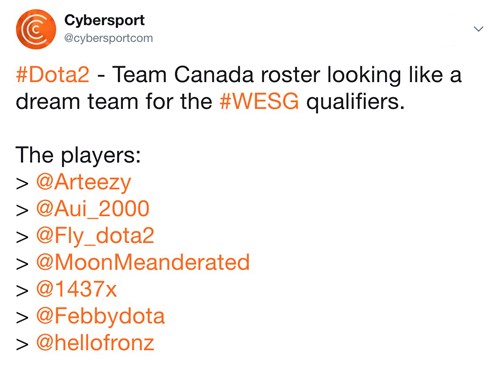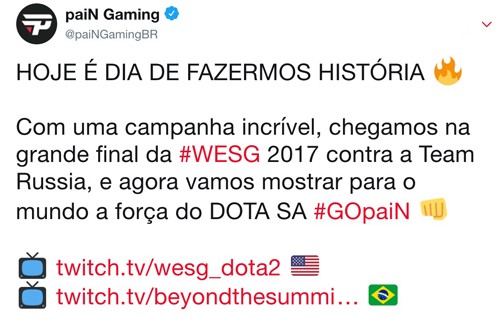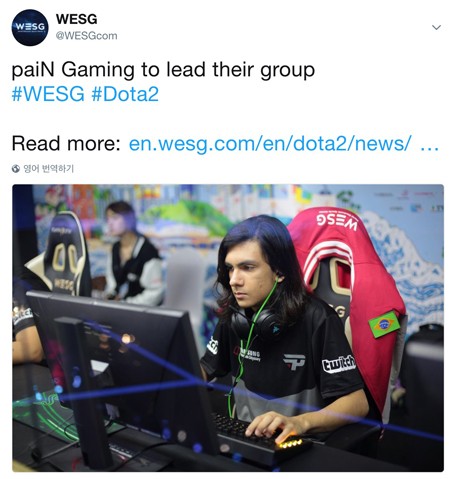
On paper, Team Russia was easily the best team in the WESG Dota 2 tournament. That panned out in practice, too, as the modified Virtus Pro squad had very little difficulty locking up a first-place finish.
After an almost casual run through the group stages, which saw the Alexei "Solo" Berezin-led team take first- and second- place in each phase, Russia turned up the heat once it reached the playoffs.
Anyone that has seen Virtus Pro play in the last 18 months knows what that means. Early aggression. Excellent play in lanes. Strong mid-game farming and a unwavering willingness to fight. That style has translated to a slew of big tournament wins (the most recent coming just a few weeks ago at the PGL Bucharest Major) and even fellow elites struggle to deal with it.
This part of Rocky IV is essentially how the WESG Dota 2 tournament panned out.
That made the lineup of tier-two teams in Haikou easy pickings for Russia, and led to convincing 2-0 wins against SG E-Sports and Team Hellas. Brazil’s PaiN Gaming was all that stood in the way of an $800,000 paycheck and while the South Americans looked surprisingly solid, they just weren’t up to scratch.
Game 1 panned out exactly as one would expect, with Russia’s cores getting strong farm in lane and taking complete control of the mid-game. PaiN was competent in drawing the game out, but never came close to throwing Russia off-balance, resulting in a slow, suffocating loss.
That was shaping up to be the case in Game 2 as well, with Russia building up Roman "RAMZES666" Kushnarev’s Troll Warlord to an almost absurd degree. A bit of wildness, however, translated to back-to-back team fight losses that allowed PaiN to invade Russia’s base and take a shocking comeback win.
The proverbial gloves came off in the deciding Game 3, however, and Team Russia posted a signature “Virtus Pro” performance. Solid early farm for Russia opened the door for a midgame bloodbath. The pressure was only raised from there and when PaiN began cracking, Russia kicked the doors down to the Brazilians’ base and forced the GG.
While this wasn’t technically a win for Virtus Pro and while the team doesn’t take any Dota Pro Circuit points for this, WESG was the latest addition to the rapidly growing trophy mantel of Dota 2’s best team. Just three months into 2018, the team has already notched two Majors victories and $1.7 million in tournament winnings.
The fact that this event is just a cherry on top says a lot.

What Could Have Been…
The WESG concept is an amazing one; become the Olympics of esports. It’s a simple idea that, while not particularly out-of-the-box, still sets it apart in an esports scene that is increasingly crowded and increasingly homogenous.
The novelty of nation-based teams is especially significant for Dota 2 fans. Outside of China and Southeast Asia, teams are typically a hodgepodge of the best talent available, with organizations like the all-Swedish Alliance squads being major outliers. Because of that, WESG should be one of the most intriguing events for fans in the Dota 2 tournament calendar.
Unfortunately, for the second year in a row, the WESG Dota 2 event was moreso defined by who wasn’t there than who was.
Team Canada (which included a star-studded lineup including Arteezy, Aui_2000, Fly, MoonMeander and Febby), as well as compelling stacks in Team USA and Danish Dynamite looked hot in qualifiers, but ultimately pulled out of the actual event. Team Ukraine withdrew last month due to visa issues. More recently, a slew of individual players attached to notable teams withdrew from the event including Echo International’s Keyser and NaVi’s LeBronDota.

Granted, there were still some compelling stacks to watch during the event. Greece’s Team Hellas (mostly) reunited 2016’s Ad Finem, Team Netherlands brought back some beloved veteran talent and Team Russia’s Virtus Pro-heavy lineup stood as the Goliaths in this tournament of Davids. For the most part, though, WESG underwhelmed fans.
A lot of this can be chalked up to the timing, of course. March is one of the busiest months in the entire 2017-2018 Dota Pro Circuit season, including two majors, two minors and a slew of qualifiers across every region. Unless a team isn’t good enough to realistically take points at a DPC event or already has a TI8 invite in its pocket like Virtus Pro, attending WESG just isn’t worth it, despite the whopping $1.5 million prize pool.
Hopefully this changes next year for WESG. While the tournament itself was fine, having Team Canada-style supergroups would be the norm and until that happens, the event just won’t get the attention it deserves.

South American Dota Acquits Itself (For Now)
As previously mentioned, the only active teams in the Dota Pro Circuit that participated in WESG were the ones that weren’t good enough to realistically take qualifying points from DPC events and Virtus Pro, who already have a TI8 direct invite locked up.
Every team in South America fits into the former category and, with that in mind, the region sent two of its best teams, PaiN Gaming and SG E-Sports (both representing Brazil), and a solid stack in Team Peru to Haikou for the tournament.
At face value, this wasn’t a big deal--China sent a respectable pair of teams while SEA sent some familiar faces--but in reality, this was something of a risky proposition for Dota 2’s weakest division. Set to face flimsy, regional-level competition, each of those teams needed to post respectable performances at WESG in order to prove that the continent has enough talent to justify its continued “must-invite” status in the Dota Pro Circuit.

While it didn’t win the event, this was still a very strong weekend for South American Dota.
In addition to PaiN Gaming’s second-place run, SG E-Sports managed to make the playoffs (and had the misfortune of playing Russia in its first series). Team Peru, led by SA journeyman Abraham "Kingteka" Canez looked reasonably good in the group stages and even played well in defeat. And the kicker? As WESG was going on, South America’s best team, Infamous, became the first team from the region to take DPC qualifying points at the GESC Indonesia Minor.
Will a South American team win The International 2018? Will more than one team from the region even qualify? No.
But after an outright ugly year, there are finally some signs of growth.
Sort by:
Comments :0






